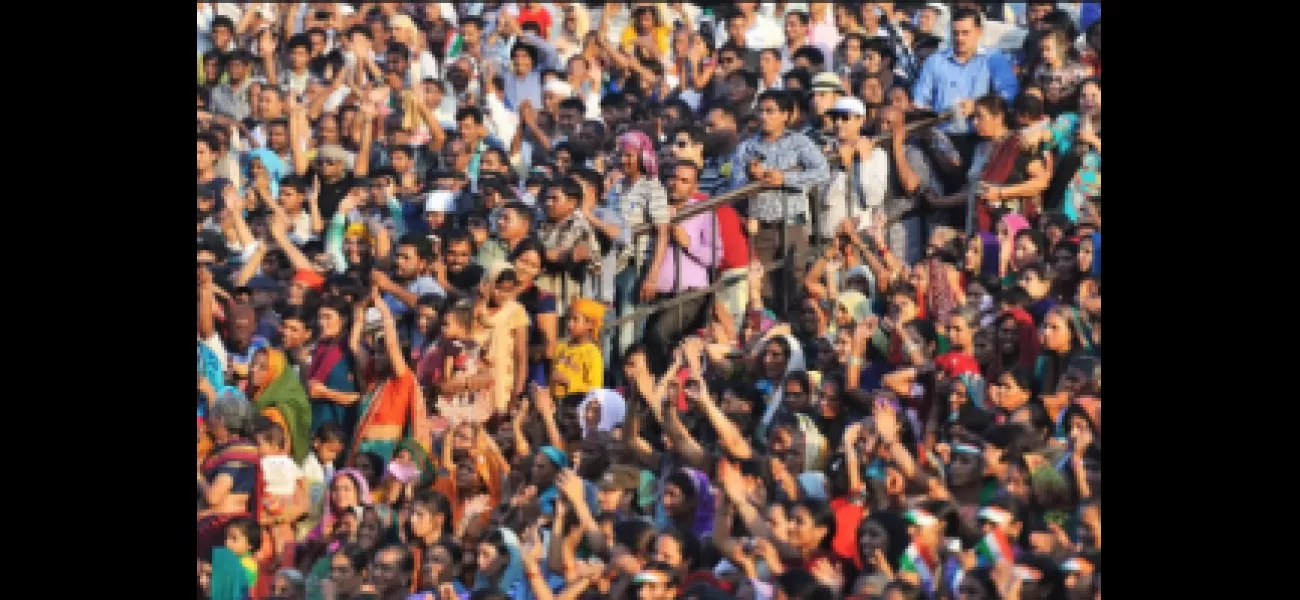"The Hindu population in India decreased by 7.8% from 1950 to 2015, while the Muslim population increased by 43.15% according to an EAC-PM paper."
Recent data shows a decrease in the Hindu population and an increase in Muslim population in India, indicating a diverse and welcoming environment in the country.
May 9th 2024.

In a recent working paper by the Economic Advisory Council to the Prime Minister, it was reported that the Hindu population in India experienced a decrease of 7.82 percent between the years 1950 and 2015. On the other hand, the Muslim population saw an increase of 43.15 percent during the same period, indicating a favorable environment for diversity in the country. The paper, titled 'Share of Religious Minorities: A Cross-Country Analysis', also revealed a decrease in the share of Jains from 0.45 percent in 1950 to 0.36 percent in 2015.
The team behind this paper, led by Shamika Ravi, member of EAC-PM, stated that "the majority Hindu population saw a decrease of 7.82 percent between 1950 and 2015, while the share of Muslim population increased from 9.84 percent to 14.09 percent during the same period - a 43.15 percent increase in their share." Additionally, the share of Christian population increased by 5.38 percent, from 2.24 percent to 2.36 percent, while the Sikh population saw a rise of 6.58 percent, from 1.24 percent to 1.85 percent. However, the Parsi population in India witnessed a drastic decline of 85 percent, reducing from 0.03 percent in 1950 to 0.004 percent in 2015.
The data presented in this report suggests that India has a welcoming environment for fostering diversity in society. The team emphasized the importance of providing a nurturing environment and societal support for the disadvantaged sections of society through a bottom-up approach. They also noted that the decrease in the share of the majority population and the increase in the share of minorities reflects the positive impact of policies, political decisions, and societal processes in promoting diversity.
The report also highlighted the global trend of declining majority populations and the increase in minority populations. India, too, has experienced a reduction of 7.82 percent in its majority religious denomination. This is especially noteworthy when compared to its neighboring countries such as Bangladesh, Pakistan, Sri Lanka, Bhutan, and Afghanistan, where the majority religious denomination has increased and minority populations have decreased significantly. The paper also noted that during times of crisis, minority populations from neighboring countries seek refuge in India due to its conducive environment.
Among Muslim-majority countries, only Maldives witnessed a decline of 1.47 percent in the share of their majority religious group. In Bangladesh, there was an 18 percent increase in the share of their majority religious group, which is the largest such increase in the Indian subcontinent. Pakistan, despite the creation of Bangladesh in 1971, saw an increase of 3.75 percent in the share of their majority religious group and a 10 percent increase in their total Muslim population. In non-Muslim majority countries like Myanmar, India, and Nepal, there was a decrease in the share of their majority religious denomination.
The paper highlighted the significance of the year 1950 as a baseline year for two major reasons. Firstly, it was around this time that international human rights framework began to take shape under the newly formed United Nations, which included the protection of minority rights. Secondly, it marked the beginning of a 65-year period, which is the duration of the analysis in this paper. The paper is a detailed descriptive analysis of the status of minorities across 167 countries, measured by their changing share in a country's population between 1950 and 2015. The average value for the share of the majority religious denomination in 1950 was found to be 75 percent, while the mean of the distribution capturing the change in majority religious denomination between 1950 and 2015 was 21.9 percent.
The team behind this paper, led by Shamika Ravi, member of EAC-PM, stated that "the majority Hindu population saw a decrease of 7.82 percent between 1950 and 2015, while the share of Muslim population increased from 9.84 percent to 14.09 percent during the same period - a 43.15 percent increase in their share." Additionally, the share of Christian population increased by 5.38 percent, from 2.24 percent to 2.36 percent, while the Sikh population saw a rise of 6.58 percent, from 1.24 percent to 1.85 percent. However, the Parsi population in India witnessed a drastic decline of 85 percent, reducing from 0.03 percent in 1950 to 0.004 percent in 2015.
The data presented in this report suggests that India has a welcoming environment for fostering diversity in society. The team emphasized the importance of providing a nurturing environment and societal support for the disadvantaged sections of society through a bottom-up approach. They also noted that the decrease in the share of the majority population and the increase in the share of minorities reflects the positive impact of policies, political decisions, and societal processes in promoting diversity.
The report also highlighted the global trend of declining majority populations and the increase in minority populations. India, too, has experienced a reduction of 7.82 percent in its majority religious denomination. This is especially noteworthy when compared to its neighboring countries such as Bangladesh, Pakistan, Sri Lanka, Bhutan, and Afghanistan, where the majority religious denomination has increased and minority populations have decreased significantly. The paper also noted that during times of crisis, minority populations from neighboring countries seek refuge in India due to its conducive environment.
Among Muslim-majority countries, only Maldives witnessed a decline of 1.47 percent in the share of their majority religious group. In Bangladesh, there was an 18 percent increase in the share of their majority religious group, which is the largest such increase in the Indian subcontinent. Pakistan, despite the creation of Bangladesh in 1971, saw an increase of 3.75 percent in the share of their majority religious group and a 10 percent increase in their total Muslim population. In non-Muslim majority countries like Myanmar, India, and Nepal, there was a decrease in the share of their majority religious denomination.
The paper highlighted the significance of the year 1950 as a baseline year for two major reasons. Firstly, it was around this time that international human rights framework began to take shape under the newly formed United Nations, which included the protection of minority rights. Secondly, it marked the beginning of a 65-year period, which is the duration of the analysis in this paper. The paper is a detailed descriptive analysis of the status of minorities across 167 countries, measured by their changing share in a country's population between 1950 and 2015. The average value for the share of the majority religious denomination in 1950 was found to be 75 percent, while the mean of the distribution capturing the change in majority religious denomination between 1950 and 2015 was 21.9 percent.
[This article has been trending online recently and has been generated with AI. Your feed is customized.]
[Generative AI is experimental.]
0
0
Submit Comment





